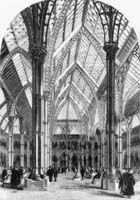The Tradescants are best known as gardeners - the father was gardener to Charles I - and they were the first people to grow exotic fruits such as pineapples and nectarines in England. They also introduced species which are now regarded as near-native, such as the larch and stocks. But they were much more than that, being great collectors of all sorts of curiosities, so that their house became known as Tradescant's Ark and was visited by Samuel Pepys, John Evelyn and Elias Ashmole, himself a great collector as well as a lawyer, historian and scientist, including a founder of the Royal Society. The Ashmoles and Tradescants became great friends.
However, the friendship came to an abrupt end when Ashmole persuaded John Tradescant junior - probably by plying him with drink - to sign the collection over to Ashmole by deed of gift. Tradescant immediately regretted the gift and tore up the deed but Ashmole took him to court and the gift was declared valid - but to take effect only after the death of both Tradescant and his wife. The former died shortly afterwards but his widow lived on for many years, under huge pressure from an increasingly obsessive Ashmole who had moved in next door to keep an eye on his eventual inheritance. Mrs Tradescant was eventually found drowned in a pond, presumably having committed suicide.
 Ashmole then gave the collection to Oxford University in 1691 to found the Ashmolean Museum - the first public museum in England. The collection was originally housed in what is now the Museum of the History of Science on Broad Street before moving to its present building in George Street. A small part of the Tradescant's collection can still be seen as the Tradescant Rareties on the first floor. There is a great variety of artefacts from all round the world, but my favourites are a delightful pocket calendar made out of wood, and a similarly miniaturised abacus, also made out of wood, from Russia. A small part of Ashmole's own collection can also be seen in the Founder's collection, also on the first floor.
Ashmole then gave the collection to Oxford University in 1691 to found the Ashmolean Museum - the first public museum in England. The collection was originally housed in what is now the Museum of the History of Science on Broad Street before moving to its present building in George Street. A small part of the Tradescant's collection can still be seen as the Tradescant Rareties on the first floor. There is a great variety of artefacts from all round the world, but my favourites are a delightful pocket calendar made out of wood, and a similarly miniaturised abacus, also made out of wood, from Russia. A small part of Ashmole's own collection can also be seen in the Founder's collection, also on the first floor.
And the natural history part of the Tradescant's collection can now be found in Oxford's Museum of Natural History in Parks Road. This is, incidentally, well worth visiting in its own right, especially to enjoy the architecture - see left. And if you cannot get there, the museum's website contains an excellent virtual tour.
John Tradescant the Elder also provided plants for Oxford's new Botanic (Physic) Garden. Magdalen College is just the other side of the road from the garden, and the college's historians believe that John Tradescant probably also provided the purple and white fritillaries that famously bloom in the college's Water Meadow every April.
Incidentally, not all Oxford's academics were impressed by the contents of the original Ashmolean. Although it was officially known as the elaboratory (hence "laboratory") it was quickly nick-named the knick-knack-atory!
The two Tradescants are buried in the churchyard of St Mary at Lambeth by Lambeth Bridge, home now of the Museum of Garden History.